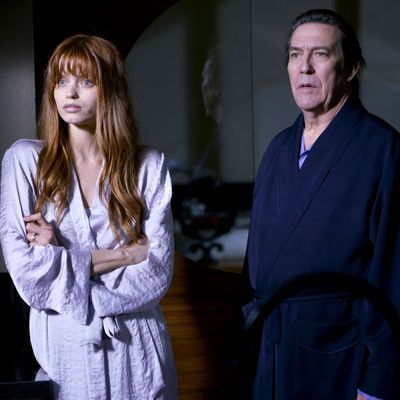
Giallo cinema is a strain of film that’s historically been hard to describe. Like pornography, you just sort of know it when you see it — which is a fitting comparison for a category of primarily Italian films born in the 1960s and trafficking in blood, naked bodies, and dime-novel mysteries. More than anything else, giallo works tend to be grouped by common narrative elements, like a foreigner who enters the story and ends up in the middle of a crime, a hatted and gloved killer, sexually motivated murders, an ineffectual detective, or an often confounding whodunit. The style-as-substance films of Lucio Fulci, Mario Bava, and Dario Argento (to list only three marquee names from the giallo boom times) made ambiance as essential a narrative component as the characters themselves.
In August, two films were released that reach right into the cinematic tool kit of those Italian masters. The phantasmagorical heist film Let the Corpses Tan, from the French filmmaking couple Bruno Forzani and Hélène Cattet, feels like it was unearthed from a time capsule planted in Rome in 1972. But it’s not an homage to the era of giallo classics and spaghetti Westerns — instead, it employs what the directors call the “vocabulary” and “codes” of those movies. Meanwhile, Elizabeth Harvest plays more like a hybrid of early Brian De Palma, 1970s Argento, and contemporary science fiction films. It’s a retelling of the Bluebeard folktale with a techno twist that has writer and director Sebastian Gutierrez ramping up the agency of his heroines compared to classic exploitation works.
Vulture spoke with the filmmakers behind Corpses and Elizabeth Harvest, digging into why the pulp murder mysteries of post-war Italy provided the best framework for their modern storytelling, how the structure of giallo films helps to engage an audience, and a few reasons why the subgenre is ready for a contemporary retooling.
The Traditionalists
In Stephen Thrower’s book Beyond Terror: The Films of Lucio Fulci, he described giallo films in part as follows: “It’s a form where murder and intrigue, those staple features of popular drama, are taken to baroque extremes, frequently bordering on the ridiculous.” Thrower’s assessment aptly maps out, in very broad terms, Let the Corpses Tan. The film centers on a gang of thieves who’ve stolen a cache of gold, and who end up hiding out in a disintegrating stone house currently occupied by a fiery, erratic artist. Eventually, a couple of cops show up at the Italian cliffside home looking for the crooks — but the minute story details are basically secondary (and extremely hard to follow) to the experience of watching the film, which is exactly what Forzani and Cattet intended.
“For us, giallo and Italian westerns are genres of mise-en-scène. There is a poetry in this language about love and death, and when we began to work in the genre it was a way to talk about desire, about body, about love and relationships,” says Forzani. Cattet adds, “There’s no place anymore for imagination, for poetry. We prefer when it’s more open, and it’s exactly the same thing when you are reading a book. You can imagine the universe.”
The directors describe their giallo influences as examples of “pure” cinema, works that present viewers with a “moment” — maybe something inexplicable, maybe something “psychedelic” — and give the audience a wide berth to have a subjective reaction based on what they’ve witnessed. Forzani and Cattet found their Corpses inspiration in vice films like Cry of a Prostitute, Jesús Franco’s Venus in Furs, the works of Sergio Leone, and the nouveau réalisme art movement that took off in the 1960s.
Taken all together, that adds up to a French-directed crime caper set in stunning Corsica that looks like a moving décollage from Mimmo Rotella, kicks like The Good, the Bad and the Ugly, and has all the visual flare of Blood and Black Lace. To an almost jarring degree for the modern American film-goer, Corpses demands an immersive commitment to viewing. You can’t two-screen a movie when every snap zoom and hallucinatory dream sequence tells you more about the plot than any piece of dialogue — and in that way, it turns the sensual aspects of a genre like giallo into an antidote for the tidy and sometimes formulaic offerings that roll off the blockbuster assembly line in Hollywood. Corpses, like the directing duo’s previous films, Amer and The Strange Color of Your Body’s Tears, will force engagement in a media landscape that is working to fracture it at every turn.
As Cattet says about the duo’s films, “You receive a lot of emotion. You live in chaos as the character, and you can try to understand what happened to you after you can see the movie. But we don’t want to tell you how to live.”
The Reformer
If Corpses made a modern art piece out of low-brow European exploitation cinema, then Elizabeth Harvest uses giallo technique with a more accessible approach to character that updates the subgenre for the present day. But like Cattet and Forzani, writer-director Gutierrez aims to seduce viewers with the outsized visual boldness of Italians like Bava and Sergio Martino.
“Everybody’s gotten so used to selfies and YouTube videos, it’s like stuff just looks ugly. What passes for ‘naturalism’ is so boring to me,” Gutierrez says. “If you watch any Hitchcock movie, or David Lynch before he grabbed the video camera, they look stunning. They’re supposed to be a gritty dream, and that to me is a much more immersive, interesting way of going into the story. Let’s make things that will stay in your mind even if you don’t pay attention to anything anybody’s saying.”
Elizabeth Harvest includes much more blatant exposition than Corpses, but the director is right: What sticks with you most are his movie’s visuals. The story follows a woman who realizes she’s actually died and been reanimated as a series of clones who are being repeatedly commissioned and killed by her mad scientist husband, Henry (Ciáran Hinds). As the story jumps between timelines, a sense of place is maintained by using dominant colors, including amber, cyan, and red, to connect viewers with particular parts of the story.
Our heroine, Elizabeth (Abbey Lee), fits the archetype of unreliable narrator, as her mind is wiped each time she’s destroyed. Henry Harvest’s collaborating scientist, Claire (Carla Gugino), is the interloper who finds herself in the middle of a crime scene. And like the giallo films of yore, Gutierrez highlights the blood and female bodies by soaking them in rich crimsons and blues. In Elizabeth’s long, meandering walks through the Harvest manse, you can see a filmmaker who drank in Argento’s Inferno by the tall glass.
Like Corpses, Elizabeth Harvest is a film of visual indulgence, but one that’s more narratively accessible to mainstream audiences. (You’re explicitly told, in almost humorous detail, what’s going on.) It’s also one that makes the welcome adjustment of empowering its heroine to actively rise up from persecution. Female characters tend to play a passive role in their own fates in giallo films — rescued by the man, driven to commit murder by blinding insanity — but Gutierrez tones down the B-movie sleaze and lets Elizabeth become her own kind of warrior, featuring her exposed body not as an object to be desecrated but as a powerful and beautiful weapon that she can embrace and use however she likes.
Similar to Coralie Fargeat’s Revenge from earlier this year, which also relied on color and music to push the narrative in place of dialogue, our female hero is not criminalized for the fact of her body just because a man desires it, and modesty is not the requisite armor of the righteous. By casting a once global modeling sensation in his lead role, too, Gutierrez deliberately presents his audience with a performer they could project expectations onto, only to have them subverted by the narrative later on. (Let’s not forget that Bava’s Blood and Black Lace was one of the first body-count horror films, and the victim roster was a set of models at a fashion house.)
Through the collision of giallo’s visual decadence with the #MeToo era’s assertive gender politics, we get a best-of-both-worlds opportunity: a teased revival of one of horror’s most visually stunning film periods, incorporating the much more savory considerations of female representation in 2018 without sacrificing the sex appeal and the salacious violence that made it so much fun in the first place. That way we can have our experimental throwback cake with films like Corpses, and eat it, too, with modernized works like Elizabeth Harvest. “It’s always tricky to rewrite history,” says Gutierrez. “But it’s like, grab the things from history that work for you and leave what you don’t need.”





